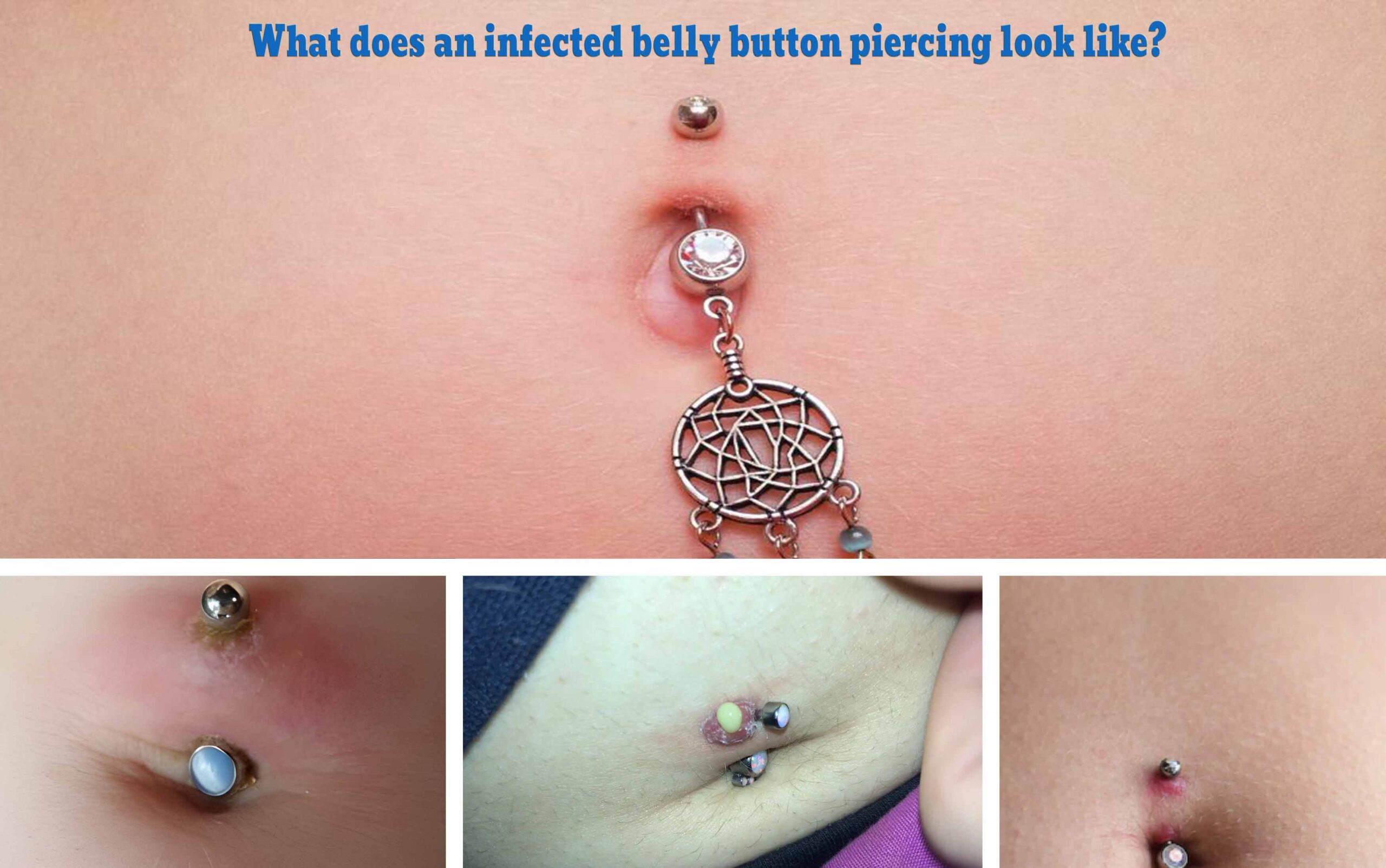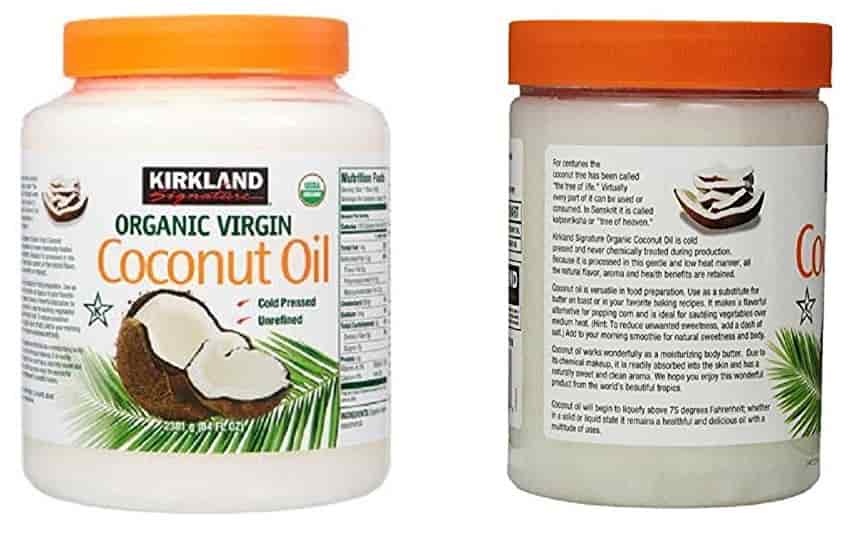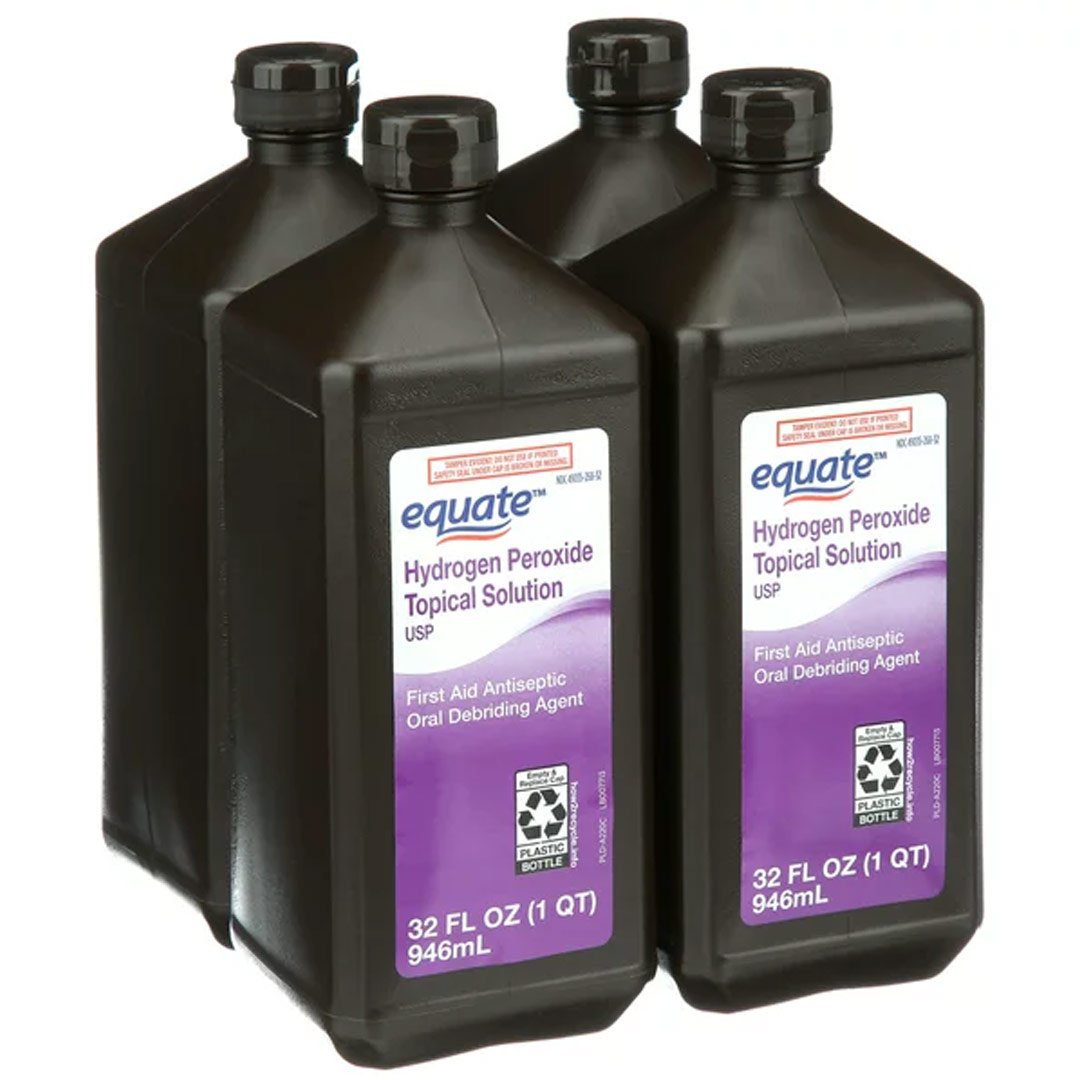The unsanitary environment and poor care after navel piercing are the leading causes of infection after piercing.
Navel piercings have become more and more popular. Navel piercings are generally safe if performed correctly and in a clean environment. An unhygienic environment and poor care after navel piercing are the leading causes of infection after piercing.
It will take from 6 weeks to 2 years for the navel piercing to heal completely. During that time, you’re still at risk of infection.
A minor injury or use of an old piercing can also lead to an infection, such as a piercing caught in a trouser buckle or belt.
Table of Contents

When you first get your belly button pierced, it’s normal to have some swelling, redness, or discoloration around the piercing area. You may even have a clear discharge and then the fluid will scab around the piercing. These symptoms will gradually improve over time.
The two most common complications after navel piercing are infection and allergic reactions.
Infection occurs when bacteria from foreign objects enter an open wound in the navel while the wound is healing. Remember that a piercing is an open wound and needs to be kept clean.
An infected navel piercing can cause swelling, discharge, fever, chills, and even abdominal pain. If your navel piercing is infected, you need to treat it properly and prevent the infection from spreading to other areas of the body.
A few days after getting your piercing, you may notice some swelling, redness, or discoloration around the piercing site. You may also see some discharge from the piercing that drains and dries and forms a scab around the piercing.
These symptoms will improve over time. These signs are completely normal and are not symptoms of an infected piercing.
However, if these symptoms occur a few weeks after the piercing or the symptoms get worse, this could be a sign of an infection. Here are the typical signs of an infected belly button piercing.
- Enlarged swelling accompanied by pain and redness
- Yellow, green, gray, or brown discharge, foul-smelling discharge
- From the piercing position, there are red lines radiating
- Fever, chills, dizziness, abdominal pain, or nausea.
How do you know if you are allergic to piercings?
An allergic reaction occurs when you are allergic to the metal that makes your piercing. For example, if the piercing is made of nickel, some sensitive people may have an allergic reaction.
Metals that are safe for piercing include:
- Medical Steel
- 14 karat or 18 karats gold
- Titan
- Ni op
- Platinum
Signs of an allergy include:
- An itchy, red rash around the piercing site may spread to a larger area.
- The piercing hole looks wider than usual
- Tension at the piercing site
The navel piercing remains sensitive and prone to bleeding for a long time after the monkey’s piercing, so strenuous exercise should be avoided for several weeks.
Do not wear clothes that are too tight or wear belts or beads around the waist. You can exercise again after about 3 weeks of piercing, but depending on each person’s condition, you should always listen to your body.
For about 5 days after your piercing, your piercing is still in the healing phase, so some redness is normal and to be expected.
Depending on the location of the navel piercing, red around the top hole may appear. This is a common spot as it is more likely to get rubbed against clothing than the lower one.
According to research and proven fact, navel piercings are more likely to get infected than any other type of piercing. Therefore, you still want to closely monitor that redness for any signs of infection so that it can be detected and treated early.
It should be observed if the red spot becomes darker or begins to change color, stings, and feels painful to the touch. The piercing may also have discharge, but the discharge should be clear but not foul-smelling. If you see a lot of pus in the navel piercing, that’s not good.
Your piercer will give you simple but specific aftercare instructions, so make sure you’re following them.
If symptoms, such as pain, redness, or discharge from the piercing improve steadily, that’s a sign the piercing may be healing normally. If you suddenly experience new symptoms, especially after a period of few or no symptoms, this could signal an infection.
So how do you know if your belly piercing is healed? You can see or feel, here are the signs that let you know your belly piercing is healing:
- The skin color around your piercing has returned to normal, the redness around the jewelry has gradually disappeared, and your skin is dry, which may feel a bit itchy as the piercing is changing skin.
- No more pain around the piercing.
- There is no discharge or mucus, or pus.
Navel piercings can become infected if not cleaned regularly after piercing. The infection can produce fluid or pus, called discharge, which may have a foul odor.
If you are wondering what an infected navel piercing looks like, here are some pictures that can help you better understand an infected navel piercing.

When you get a piercing on your navel or anywhere else on your body, your body reacts to foreign objects that invade your body. That’s why the piercing can be rejected and the wound may not heal for some people, especially those who are sensitive and allergic to the piercing.
Here are some tips to help you avoid getting an infection while getting your navel piercing.
Keep the piercing open
If you suspect you have an infection, do not attempt to remove the piercing on your own. Most piercings do not need to be removed to treat an infection.
Keep the piercing open at all times so that fluid and pus can drain. Sealing the piercing can cause the infection to get “trapped” in the body and possibly cause an abscess.
Clean the piercing site
Cleaning the piercing site is very important, both to prevent infection and to help treat it. Experts recommend that you should not wash the piercing site more than twice a day.
Mix ½ teaspoon of border salt with 1 cup of clean water to disinfect and clean the piercing site, then use a mild antibacterial soap and water to clean the piercing site again. You can use only one of these methods, or a combination of both.
Do not use alcohol or hydrogen peroxide to disinfect as these can dry out and irritate the skin around the piercing.
In addition, you should also remember to wash your hands with antibacterial soap, then, use a cotton ball or gauze soaked in cleaning solution (1 of the 2 solutions above) and gently wipe the area around the navel and piercing. Then, use a clean towel to gently pat the skin around the navel to dry.
Warm compress
Place a warm compress on the piercing area. This will help drain the pus and reduce swelling.
You can dip a clean towel in warm water mixed with a cleaning solution and then place it on the piercing area. Once you’re done, gently wipe the area with a damp cloth.
Use antibacterial cream
Use an antibacterial cream – not an ointment – to clean the infected area. Ointments are often heavy in texture and may prevent oxygen from entering the wound, and prolong the healing process.
However, you should also be careful when buying antibacterial creams because some people who are sensitive, may be allergic to the ingredients in these products.
If you are not allergic to these ingredients, you can gently clean the piercing area and then follow the directions for use of the antibacterial cream.
Usually, most body piercings are quite safe, including navel piercings. Even so, there are still cases where the piercings can become infected by bacteria and germs that get into the pierced area. If a belly button piercing becomes infected, it can cause pain, swelling, redness, discharge, and swelling around the infection.
When you see any abnormalities or suspect that your navel piercing is infected, you need to quickly consult a specialist or doctor. It is also important to limit contact of the piercing with water or other objects to avoid further injury.
Please note that not any symptoms such as swelling, pain, or bleeding are indicative of an infected navel piercing. When you notice anything unusual or uncomfortable on your belly button, find out the cause behind that discomfort. Be aware that wearing new piercings can cause swelling, pain, light bleeding, and redness.
According to research published in Healthline, it can take up to 2 years for a Belly Button Piercing to heal completely. During this time, you must not be subjective and must pay attention to carefully clean the piercing hole.
The early-stage infected belly button piercing often has some of the following signs: severe pain or a burning sensation at the site, bright red skin around the piercing, or red streaks that come from it, a fever, the area around the new piercing may be red, tender, and/or swollen for several weeks.
An infected navel piercing can cause an abscess. A swollen pocket above your navel piercing that contains pus is an abscess. Any abscess that forms on your body is a clear sign that the site is infected. Swelling from an abscess may be accompanied by some pain or may even cause a fever.
The most important is the care and hygiene of the piercing after piercing. It is necessary to detect early signs of abnormalities in the piercing for timely treatment.
Here are some safe and effective home remedies for an infected navel piercing:
Coconut oil

Coconut oil is composed of medium-chain fatty acids that have exceptional anti-inflammatory and antibacterial properties. These features not only support infection-causing bacteria but also aid in the treatment of pain and inflammation in the navel.
You will need
- Coconut oil (on request)
What you have to do
Take a small amount of coconut oil on your finger and apply it directly to your navel. Leave it as it is and let your skin consume the oil.
How often should you do this?
Do this at different times of the day.
Saltwater
Saline helps reduce the moisture inside your navel, preventing further infection. Salt has antibacterial and anti-inflammatory properties. This can help fight actual infections as well as itching and swelling in the navel.
You will need
- 1 teaspoon salt
- 1 cup of warm water
What you have to do
Combine a teaspoon of salt with a cup of warm water and mix well. Put a few drops of this physiological saline in the abdomen or use a cotton ball to soak the water into the navel.
How often should you do this?
You can do this several times per day until satisfaction is achieved.
Warm Compress
Hot compress is really beneficial when you use it, especially to fight infection, and reduce pain and swelling in the body. So it can be a great idea if you use a hot compress on the area where you feel soreness and general infection.
You will need
- Hot water
- A clean towel
What you have to do
Get a new towel and soak it in medium-hot water. Strain off excess water and place the warm compress right above your navel. Let it rest for a few minutes. Repeat as needed.
How often should you do this?
You can schedule this 2 to 3 times per day.
Essential oils
Tea tree oil
Tea tree oil is one of the best home remedies you can use for an infection. It has all the anti-fungal, antibacterial, and anti-inflammatory properties needed to relieve irritation and colic. These properties can help kill the bacteria causing the infection and help relieve pain, swelling, itching, and more.
You will need
- 2-3 drops of tea tree oil
- 1 teaspoon coconut oil
What you have to do
Add a little tea tree oil to a teaspoon of coconut oil and mix well. Apply this mixture directly to the infected navel. Leave it on for 15 to 20 minutes. Wash it off.
How often should you do this?
Do this 2 to 3 times per day for a more active recovery.
Silver strawberry essence
Peppermint is known for its pain-relieving properties and can reduce inflammation. It also has some antifungal and antibacterial properties that help get rid of the bacteria-causing bacteria in your body.
You will need
- 2-3 drops of peppermint oil
- 1 teaspoon coconut oil
What you have to do
Mix peppermint oil with coconut oil. Apply this mixture to your navel and let it sit for 10 to 15 minutes. Wipe clean with a paper towel.
How often should you do this?
You can do this 2 to 3 times per day until you see relief.
Hydrogen Peroxide

Hydrogen peroxide is especially beneficial if you’re using it with a pus-filled blister at your navel. Its purifying properties can fight disease while its drying properties can promote growth healing.
You will need
- 1 tablespoon 3% hydrogen peroxide
- 1-2 tablespoons of water
- Cotton cloth
What you have to do
Mix hydrogen peroxide with water. Dip a cotton pad in it and use it on your navel. Leave on and let dry freely.
How often should you do this?
Do this only once per day.
White Vinegar
Vinger has acetic acid in it which has antiseptic properties and properties that help fight any kind of infection in your navel. It also has antiseptic properties that will help you get rid of any bacteria in the belly button.
You will need
- 1 tablespoon white vinegar
- 2 tablespoons of water
- Cotton cloth
What you have to do
Combine one tablespoon of white vinegar and two tablespoons of water. Dip a cotton pad in this mixture and use it directly on the painful area. Leave it on for 15 to 20 minutes. Rinse with water.
How often should you do this?
Do this 2-3 times daily until the infection is healed.
Aloe vera
Aloe vera gel is generally recognized as having excellent healing properties. The plant consists of more than 200 medically cared-for ingredients, which show anti-inflammatory and antibacterial properties. These features can aid in improving actual umbilical cord infections while also reducing inflammatory markers.
You will need
- Aloe Vera Gel
What you have to do
Apply aloe vera gel directly to the painful area. Leave it on for about 15 to 20 minutes, then you can wash it off with water.
How often should you do this?
Do this 2 to 3 times per day.
Turmeric
Turmeric is the golden gift that is considered one of the best remedies to treat any type of infection in the body. It also contains an element called curcumin which has powerful antibacterial and anti-inflammatory properties.
This element can also help with healing and reduce swelling significantly. It will also reduce itching and inflammation caused by the infection.
You will need
- 1 teaspoon turmeric powder
- Water (on request)
What you have to do
Combine a teaspoon of turmeric with enough water to make a thick paste. Apply the patch directly to your navel. Let it dry and then wash it off with water.
How often should you do this?
Do this at least once per day.
Indian Lilac (Neem)
Neem is often used to treat various ailments because of its powerful antibacterial and anti-inflammatory properties. It not only stimulates wound healing but also reduces itching and swelling in the navel.
You will need
- A handful of neem leaves
- Clean water
- A little turmeric (optional)
What you have to do
Crush a handful of neem leaves with water to make a soft paste. You can also combine turmeric juice with this blend for extra perks. Apply the paste to the infected navel and leave it on for 15 to 20 minutes or until it dries completely. Rinse with water.
How often should you do this?
Do this 1 to 2 times per day.
Isopropyl Alcohol
The sterile nature of cleansing alcohol (isopropyl alcohol) cleans and purifies the navel, limiting further infection from developing.
Caution: Applying alcohol can dehydrate your skin and should not be applied more than twice daily.
You will need
- Isopropyl Alcohol
- Cotton cloth
What you have to do
Take a few drops of rubbing alcohol on a cotton pad and apply it directly to the painful area.
Leave it on until it dries.
How often should you do this?
Do this 1 to 2 times per day.
These home remedies are natural and chemical-free and will help you fight any kind of fiction and inflammation. If you recently had a piercing or have medical conditions like diabetes that caused you to have an abdominal infection, these remedies will help you fight it.
Here are some other tips to help you limit and prevent an infected navel piercing:
- Wash your hands thoroughly before reaching for the navel piercing.
- Do not lie on your stomach while sleeping.
- Wear loose clothing made of natural materials.
- Shower daily.
- Rinse thoroughly and make sure there is no soap residue left in the abdomen.
- Reduce your consumption of processed foods if you are predisposed to Candida infections.
- Stay away from public pools for a while after your navel puncture.
- Avoid junk food and get more raw fruits and vegetables.
- If you feel that your infection is not healing even after taking all measures, you can quickly seek medical assistance immediately.

